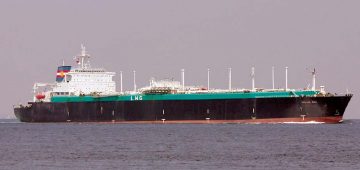by Mike Briant
A British troop ship, in the days of troopships, served two masters. Owned and managed by one of the big shipping companies (traditionally Bibby or B.I.) but on permanent contract to the Department of Defence and though manned by Merchant seamen and operated on regular Merchant Service lines, earned her keep carrying Pongos, of all descriptions to and from those places where they were needed.
In peacetime, this meant visiting various military bases, changing out personnel, but in time of war she would fall under the direct orders of the War Office to support hostilities. At such times, other Merchant passenger ships could also be requisitioned at short notice, taking on the MOT livery, buff funnel, white hull and broad blue band at the sheer, and while still flying the red duster, packing troops into every available space.
Dilwara carried a large B.I. Lascar crew and Company officers. The only non B.I. members on her articles were the Trooping Officer, permanently appointed to the ship as liaison, and six nursing sisters. The former was a beleaguered infantry major of infinite patience and diplomacy. The latter, ladies of the the Queen Alexandra Imperial Military Nursing Service, the QAIMNS, sometimes unkindly referred to as Queer Assortment of Individuals, Mainly Non-Sexual. These were career service nurses, dedicated to a calling which, in peacetime, found them generally with not enough to keep them busy.
Our deployment was mostly in the Mediterranean, a milk-run serving the garrisons of Malta, Gibraltar, Tripoli, Limassol and sometimes Aden. A sporadic guerilla war then in progress on Cyprus, had us supplying British Tommies for the Cypriots to shoot at while they vainly strove to keep Greeks and Turks from tearing at each others throats. The ship had a fully equipped hospital and operating theatre, though the only casualties carried while I served there were those inflicted by the Cypriot guerillas, quite severe injuries in some cases, often from booby traps, and requiring us to take on a RAMS surgeon, who would usually be seasick most of the way home. The method of loading stretcher cases was interesting, simple but efficient. Numbers 3 or 4 lifeboats would be lowered to the waterline or quayside level. The stretcher cases would then be loaded into the boat and raised to the boat deck, with a nurse in attendance. From there they could be wheeled straight into the hospital or O.R. Our only involvement as cadets was in operating the lifeboat falls but I was always impressed by the calm and caring efficiency of those ladies, our nurses most of whom had seen plenty of real war and more than enough of its bloody results.

Speaking of which, how many enjoy watching those old episodes of MASH the American TV series about a U.S. field hospital during the Korean war. There is something unusually poignant about the theme and the relevance of its characters – professional civilians in uniform serving, not always comfortably, alongside career military wallahs. My father knew a comparable situation during WWII. Major Margaret (Hot Lips) Houlahan of MASH often reminds me of those faded and forgotten Nightingales of the Queen Alexandra’s own.
Our bumbling perambulations got thrown into overdrive in 1956, when President Abdul Nasser seized the Suez Canal and took the Anglo French Canal staff captive. There was a brief period of prevaricating, during which we were ordered home, then, suddenly we were at war. With amazing speed and efficiency we embarked battalions of troops, fully kitted and loaded for war, and joined a combined British-French task force headed hot-foot for Egypt. By the time we entered the Mediterranean it was all over. A jittery President Eisenhower, intimidated by threats from the Soviet Union, demanded that the British and French call the whole thing off, and a weak-kneed Anthony Eden complied. By that time the Egyptian army had already been chased halfway across Egypt by a handful of allied paratroops and the Israelis had taken the Sinai peninsular. A somewhat deflated Dilwara put in to Cyprus where we dropped off our invasion force and went swimming in Limassol Bay.
Later we re-embarked other British troops in a somewhat battered Port Said, among them some extremely vitriolic and frustrated Commandos, and we took the whole lot back to Blighty. The Gyppos got the Suez Canal handed to them on a plate, the Israelis were obliged to relinquish Sinai and Eden resigned as Prime Minister.
Not long after B.I. took delivery of the biggest and most modem troopship ever built, the Nevasa. The company, in it’s declining years had a knack of shooting itself unerringly in the foot. A new Labour government promptly decided that all troop movements in the future be airborne. The troopship, at the stroke of a pen, became as redundant as the Ark, in a world of peace, no longer needed!

Some twenty years on and the Argentinians precipitately invaded the Falklands. The British quickly put together an assault force to kick them out again. Once again the Americans thought to intervene but came up against a resolute Maggie Thatcher, the Iron Lady was not to be dissuaded, certainly not by a quacking Kirkpatrick. Immediately came the problem of transporting large numbers of troops a considerable distance. Air lifting was out of the question and there were no longer any troopships available. Passenger ships had to be requisitioned at short notice, the Merchant Navy once again answering the call. Given the option to stand down, the entire complement of the QE 2, the Canberra and B.I.’s Uganda with only one or two exceptions volunteered and went off to serve in the Falklands.



Comments
Sorry, comments are closed for this item